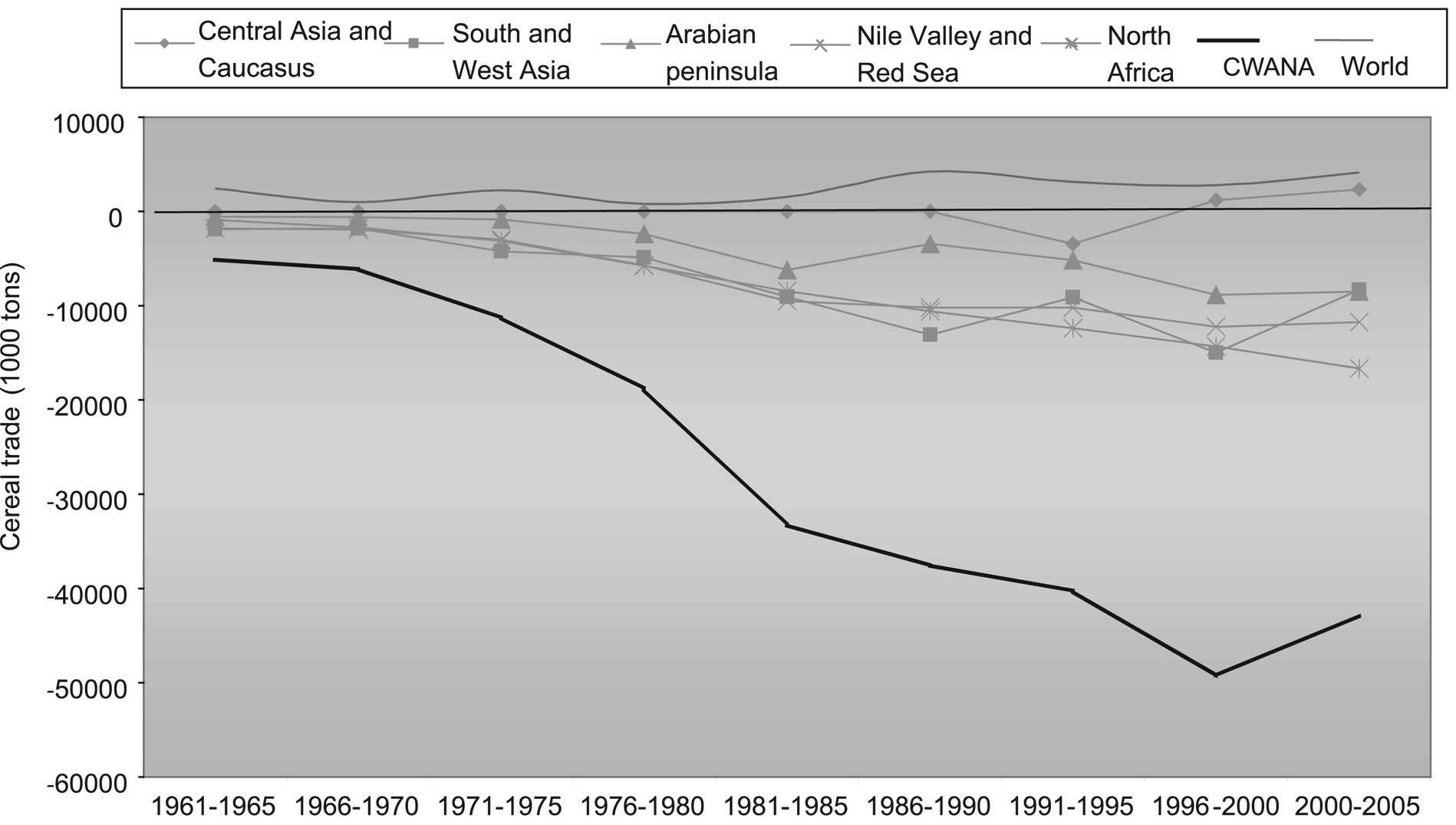
| Previous | Return to table of contents | Search Reports | Next |
| « Back to weltagrarbericht.de | ||
Historical and Current Perspectives of AKST | 61

Figure 2-3. Cereal trade in CWANA subregions, 1961-2005. Source: FAO database
|
the 1960s. As a consequence, wheat flour exports increased considerably, to almost a fifth of the world total wheat flour exports in the 2000s. More than half (56%) of the CWANA exports are generated by South Asia and West Asia. Among the different regions worldwide, CWANA stands out with the highest annual average growth rate, 8.2%. This comes from the large increases in Central Asia, Caucasus, South Asia and West Asia (Table 2-16). North Africa increased its total exports during 1996 to 2000, while exports of wheat flour from the Nile Valley and Red Sea subregions witnessed a significant drop during the 2000s. Meanwhile, the market shares of developed regions, North America or Western Europe, saw a tremendous decrease since the early 1990s, a consequence of the development of the milling industry in developing regions. This U-turn will probably continue for food processing in industrialized regions specializing in high-value products. The developing world will invest more in primary processing for the domestic market and exports. 2.4.1.2 CWANA in international trade of oil crops Most CWANA subregions that exported oilseeds in the 1960s became dependent on the international markets for their domestic supply. The downward trend started during the mid-1980s, pulling the region's trade balance toward the deficit side since the early 1990s. The abandonment of public policies encouraging oilseed production, mostly in Turkey, had a negative effect on production. The established oil-processing industries started to import most of their raw material from international markets. This deliberately chosen strategy, designed in Turkey and agreed upon by both public authorities and oil processors, saw advantage in the low world prices. Because of this deliberate choice in most CWANA countries, the entire region became dependent on international commodity markets for oilseed. Other developing regions more or less followed the same trend; North America, Latin America, the Caribbean and Oceania saw their shares increase tremendously. Western Europe, already |
dependent on international oilseed markets for its domestic supply, witnessed its deficit deepen. The most significant oilseed deficit is in Asia. This region had a surplus oilseed trade balance of more than 1.5 million tonnes in the early 1960s, but it had a 7.7 million tonnes oilseed deficit in 2001 to 2004, primarily from the sourcing strategies of multinational enterprises. This international division of world commodity markets may be an important constraint for CWANA, if these countries cannot develop activities for creating wealth to replace products abandoned in the last four decades. 2.4.1.3 CWANA in international trade of processed food A direct result of urbanization and the increase in urban purchasing power is the increased demand for processed food. As economic employment of women increases, family structures move toward nuclear families. In nuclear families the parents and children form the nucleus, so meals prepared by female family members other than the mother decrease. At the same time, families are starting to live farther and farther away from work and school, causing a decrease in time spent at home and an increase in the demand for ready-to-eat meals. In addition, the percentage of meals eaten out by families increases. In the CWANA countries, a rather hybrid sociocultural structure can be observed. When there are extended family structures including grandparents and younger siblings of the parents, typical fast-food consumption patterns are developing. Accordingly, industrial processing enterprises focus on generic products; fresh dairy products, cheese, biscuits and pasta, beer and soft drinks are being manufactured at a rapid pace. Also, export industries, based on traditional agricultural products, are developing an industrial structure. In this panorama, exports increase as a result of the gain in international competitiveness among the national food processing enterprises, while processed food imports also increase from increasing domestic demand for more sophisticated, high-value food. |
| Previous | Return to table of contents | Search Reports | Next |
| « Back to weltagrarbericht.de | ||